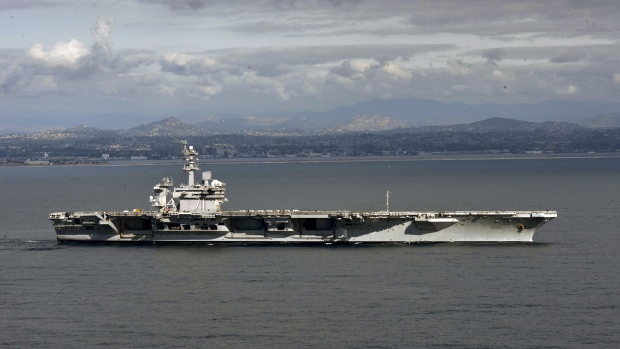Feb 9, 2021
U.S. South China Sea Exercises Signal Biden’s Stance Against Beijing Claims
, Bloomberg News

(Bloomberg) -- Two U.S. carriers conducted a military exercise in the South China Sea, signaling that U.S. President Joseph Biden and his administration are taking a strong stance to oppose China’s territorial claims in the disputed waters.
The dual carrier operations by the Theodore Roosevelt Carrier Strike Group and the Nimitz Carrier Strike Group on Tuesday conducted a “multitude of exercises aimed at increasing interoperability between assets as well as command and control capabilities,” the U.S. Navy said in a statement. The exercises were used to demonstrate the Navy’s ability to operate in challenging environments, it said.
“Through operations like this, we ensure that we are tactically proficient to meet the challenge of maintaining peace and we are able to continue to show our partners and allies in the region that we are committed to promoting a Free and Open Indo-Pacific,” Rear Adm. Doug Verissimo, commander, Carrier Strike Group (CSG) Nine, said in the statement.
U.S. Seventh Fleet spokesman Lieutenant Joe Keiley said the carriers were operating in the southern part of the sea and “not near” the disputed Paracel or Spratly islands.
The dual carrier operations come as Biden seeks to send a signal to both U.S. allies and China that the U.S. will continue to patrol the South China Sea, of which China claims more than 80%. On Feb. 5, the USS John S. McCain conducted a freedom of navigation operation in the vicinity of the Paracel Islands.
Where a U.S.-China Clash May Occur in the South China Sea
“In the past the U.S. emphasized its policy mainly verbally, but since the Trump administration it has been promoting it much more explicitly with specific actions such as dispatching its two aircraft carriers to the South China Sea,” said Yongwook Ryu, an assistant professor at the National University of Singapore’s Lee Kuan Yew School of Public Policy who focuses on East Asia. Biden “is sending out a clear message to Beijing that it is not going to be soft toward China on certain issues, including the South China Sea disputes, despite its willingness to cooperate with China on some other issues such as climate change.”
Vietnam, the Philippines, Taiwan, and China are among those that claim sovereignty to parts of the South China Sea.
“The U.S. side has been frequently sending its military vessels to the South China Sea to flex its military muscles,” Chinese Foreign Ministry spokesman Wang Wenbin said on Tuesday in response to a question about the U.S. operation. “China will continue to take necessary measures to ensure our sovereignty, security and development interests. We will work with regional countries to ensure the peace and stability of the South China Sea.”
New U.S. Secretary of State Antony Blinken said in a late January call with Philippine counterpart Teodoro Locsin that Washington rejected Beijing’s maritime claims in the waters if they exceeded the maritime zones that China was permitted under international law. He pledged to stand with Southeast Asian claimants in the face of Chinese pressure.
The last time the U.S. conducted a dual carrier operation in the South China Sea was last July. About a month later, China sent a series of missiles into the South China Sea as a warning to U.S. aircraft carriers and regional bases.
(Updates with analyst comment.)
©2021 Bloomberg L.P.






